
Image Credit: Department of Veterans Affairs
The religious meaning associated with the above symbol seems hard to miss. Different denominations may favor different variations, but the Latin cross is inextricably associated with Christianity. Yet, in the context of legal arguments over the separation of church and state, some suggest that the cross conveys a meaning other than an identification with the Christian religion. Oddly enough, these arguments for a non-Christian Christian cross often come from those deeply invested in preserving the presence of crosses and other ostensibly religious symbols on government property.
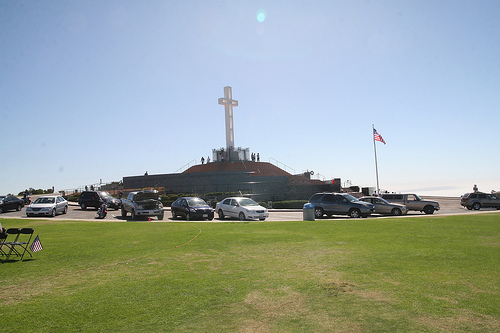
Image Credit: Joe Crawford
Since 1954, the Mount Soledad Easter Cross, the original name of the monument pictured above, has looked out over San Diego. Since 1989, litigants have participated in a decades-long struggle to challenge or defend the structure on state-church separation grounds. Generally speaking, government can neither inhibit nor support religion, such as by providing a city park as a site for a permanent religious display and worship. However, the question of where to draw the line between constitutional and unconstitutional religious displays has proven difficult both to resolve and to discuss in a productive matter.
In the Mt. Soledad case, for instance, the site had been used for Easter worship services. Once litigants filed a complaint that the religious symbol should not sit on government property, defenders of the cross' position redefined it a veterans' memorial instead of a worship site. The courts were not persuaded by this redefinition, ruling against its continued presence. At that point, defenders worked with the city to sell the land immediately surrounding the cross to a non-governmental third party in an attempt to get around state-church separation concerns.
A less prominent, more remote cross that sat on government-owned land in the middle of the desolate yet stunning Mojave desert has faced similar legal challenges and received similar support from those who try to re-define an iconic image to mean something other than its iconic meaning.
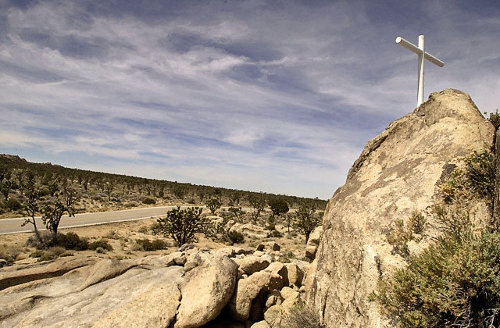
Image Credit: AP Photo/The Press-Enterprise, Carlos Puma
Unlike the Mt. Soledad cross, the Mojave cross was originally created as a war memorial in 1934, not as a worship site. The Mojave cross sat on a wild rocky rise, unlike the well groomed park at the top of Mt. Soledad, though both look out from prominent positions. The more primitive construction of the Mojave cross and its more remote location seem to enhance its iconic imagery (regardless of what meaning one reads into the icon), standing as a lone symbolic structure in nature, as opposed to the Mt. Soledad cross that stands a few minutes travel from the hustle and bustle of San Diego.
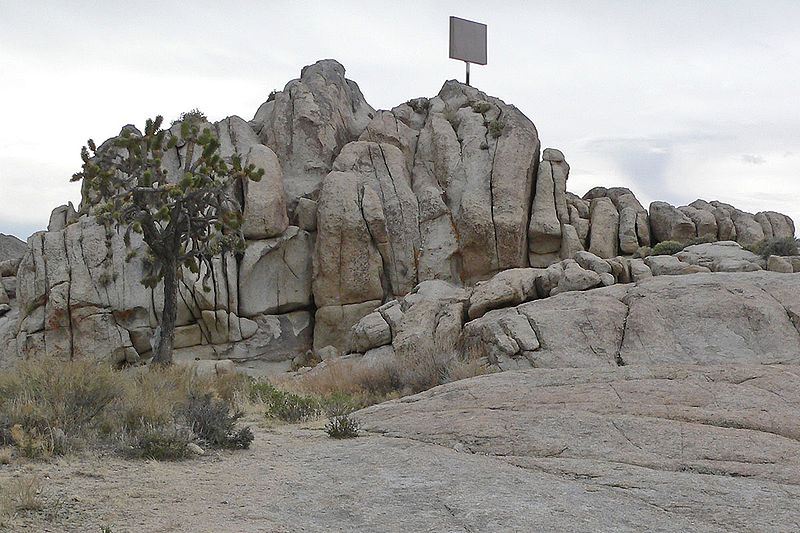
Image Credit: Stan Shebs
The early legal challenges to the Mojave cross resulted in it being encased in a plywood box. As with the Mt. Soledad case, a land-transfer was made to move the Mojave cross off government property. Litigants challenged the transfer, but the Supreme Court ruled that it was an acceptable solution to the state-church issues and sent the case back to a lower court to rule. Soon after, the cross was stolen.
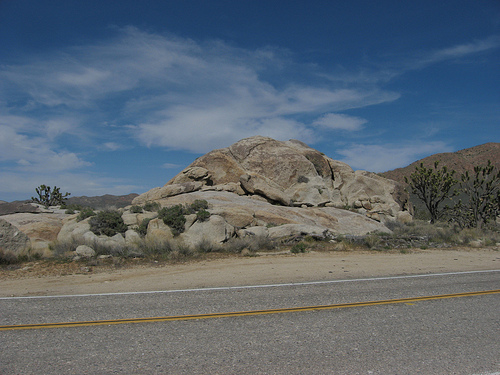
Image Credit: Ken Lund
The Mojave case raises difficult questions about the meaning of symbols in a diverse society. Those who objected to the cross, saw the cross as exclusionary. For example, the Freedom From Religion Foundation said, “Sectarian symbols such as the Latin cross sanctioned by government as war memorials neglect the sacrifices of our non-Christian and non-believing veterans.” Some of those defending the cross denied the religious meaning of the cross, such as American Legion representative Mark Seavey who said, “The cross is emblematic of sacrifice, not religion.”
The Supreme Court justices were also divided on this question of whether a symbol that has religious meaning can serve as a symbol of sacrifice for all regardless of their religious beliefs.
Justice Kennedy, writing for the majority, argued:
But a Latin cross is not merely a reaffirmation of Christian beliefs. It is a symbol often used to honor and respect those whose heroic acts, noble contributions, and patient striving help secure an honored place in history for this Nation and its people. Here, one Latin cross in the desert evokes far more than religion. It evokes thousands of small crosses in foreign fields marking the graves of Americans who fell in battles, battles whose tragedies are compounded if the fallen are forgotten.
Kennedy, unlike Seavey, does not dismiss the cross's religious meaning. Instead, he suggests that a meaning of sacrifice overrides the religious meaning at least for constitutional purposes. Writing in his dissent, Justice Stevens says:
I cannot agree that a bare cross such as this conveys a nonsectarian meaning simply because crosses are often used to commemorate "heroic acts, noble contributions, and patient striving" and to honor fallen soldiers. The cross is not a universal symbol of sacrifice. It is the symbol of one particular sacrifice, and that sacrifice carries deeply significant meaning for those who adhere to the Christian faith.
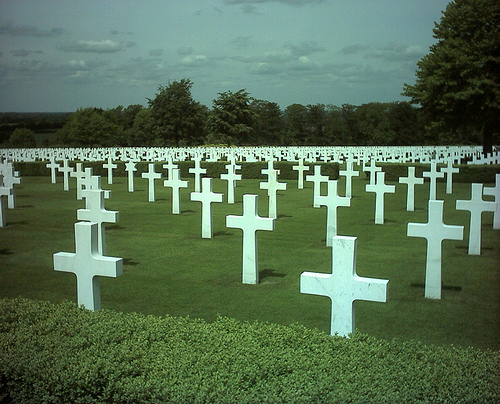
Image Credit: Marco Chiesa
Justice Kennedy invokes images of European cemeteries from World Wars I and II, and the cumulative effect is a moving reminder of sacrifice. Though, as Justice Stevens suggests later in his dissent, remembrance does not depend on the symbols being crosses, and, indeed, crosses were not the exclusive symbol used to mark grave sites. In the above picture one Star of David marker is visible among a multitude of crosses. Nevertheless, given the normative value of Christianity for American identity in those historical eras, it isn't surprising to see nearly all graves in a given view marked with crosses.

Image Credit: Prashanth Raghavan
Unlike the cross-shaped markers in the European cemeteries that Justice Kennedy mentions in his opinion, markers provided by the Department of Veterans Affairs in the US indicate religious preference in a different way. The upright headstones or flat markers all share the same shape, though next of kin can elect to have an “emblem of belief” engraved onto the face of the stone.
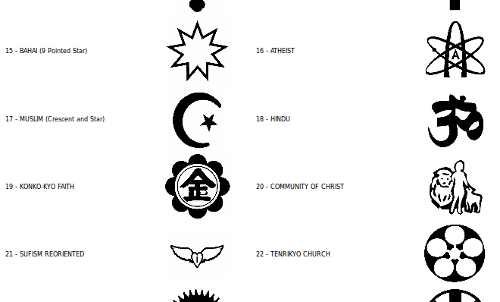
Image Credit: Department of Veterans Affairs
There has been some controversy in getting the VA to accept certain symbols, but the Department currently hears applications for new emblems of belief in addition to the fifty-plus emblems already approved. In most photos, the dominant emblem remains the Christian cross, yet a wide range of other emblems bear witness to the diverse worldviews of veterans, ranging from atheism to Wicca.
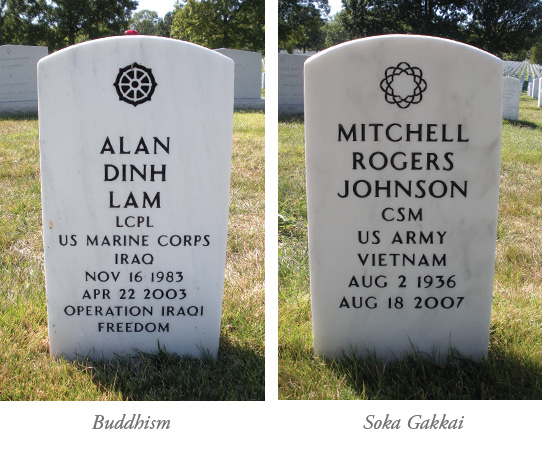
Image Credit: John Hamer
Blogger John Hamer remarks on the wealth of diverse religious identifications he saw while at Arlington and Fort Leavenworth National Cemeteries. The cumulative effect of row upon row of markers that look similar from a distance yet reveal individual differences upon closer examination conveys Kennedy's message of remembrance while also evoking the American principle of e pluribus unum that a lone, large cross does not convey.









Recent comments
2 years 29 weeks ago
2 years 44 weeks ago
2 years 44 weeks ago
2 years 50 weeks ago
3 years 4 weeks ago
3 years 4 weeks ago
3 years 4 weeks ago
3 years 6 weeks ago
3 years 6 weeks ago
3 years 6 weeks ago